Drill bits are essential tools for creating holes in various materials like wood, metal, and masonry. They come in different types and sizes, offering versatility for precise results.
1.1 What Are Drill Bits?
Drill bits are cutting tools attached to power tools like drills and presses. They are designed to remove material and create holes in various surfaces. Available in diverse shapes, sizes, and materials, they cater to specific tasks, ensuring precision and efficiency. From woodworking to metalworking, drill bits are indispensable for both professionals and DIY enthusiasts, offering versatility for countless projects.
1.2 Importance of Choosing the Right Drill Bit
Selecting the correct drill bit is crucial for achieving precise results and ensuring safety. The wrong bit can lead to poor finish, material damage, or even accidents. Proper bits optimize efficiency, reduce wear on tools, and extend material longevity. For tasks like woodworking or metalworking, the right bit ensures clean cuts and prevents overheating. Investing in quality drill bits enhances overall performance and guarantees lasting results.
Types of Drill Bits
Drill bits vary widely, including twist, spade, Forstner, and countersink bits. Each type is designed for specific materials and tasks, ensuring precise and efficient results in woodworking, metalwork, and masonry.
2.1 Twist Drill Bits
Twist drill bits are the most common type, known for their versatility and efficiency. They feature a helical flute design that removes debris effectively. These bits are suitable for drilling in wood, metal, and plastic. Their sharp cutting edges ensure precise holes, making them ideal for general-purpose drilling across various materials and applications, from DIY projects to industrial settings.
2.2 Spade Drill Bits
Spade drill bits are characterized by their flat, paddle-like shape with a central point for stability. They are ideal for quickly drilling large, rough holes in wood. Often used in woodworking and construction, spade bits are cost-effective and durable. They are capable of creating holes at various depths but may not provide the precision of other drill bit types, making them best suited for applications where speed and efficiency are prioritized over fine detail.
2.3 Forstner Drill Bits
Forstner drill bits are designed for precise, flat-bottomed holes in wood, ideal for applications like cabinetry and furniture making. Their unique design features multiple cutting edges and a central spur for stability. These bits excel at cutting clean, accurate holes without tearing the wood, making them essential for projects requiring high-quality finishes. They are typically used at slower speeds to maintain control and ensure optimal results in woodworking projects.
2;4 Countersink Drill Bits
Countersink drill bits are specialized tools designed to create conical holes in materials like metal and plastic. They combine a twist drill bit with a countersinking portion, allowing for precise pilot holes and countersinking in one operation. These bits are ideal for setting screws or rivets flush with the surface, preventing damage to the workpiece. Their versatility makes them essential for various projects, ensuring smooth and professional finishes in both woodworking and metalworking applications.
Materials and Construction
Drill bits are crafted from high-quality materials, such as high-speed steel and carbide, ensuring durability and precision. Their advanced design contributes to efficient drilling in diverse materials, offering great versatility.
3.1 High-Speed Steel (HSS) Drill Bits
HSS drill bits are a popular choice for their excellent heat resistance and durability. They are suitable for drilling into metal and offer long-lasting performance. These bits are cost-effective and ideal for general-purpose drilling applications, making them a favorite among professionals and DIYers alike. Their versatility ensures they remain a staple in many workshops and toolboxes.
3.2 Carbide-Tipped Drill Bits
Carbide-tipped drill bits are highly durable and designed for drilling through tough materials like steel, concrete, and masonry. The carbide tip provides exceptional hardness and heat resistance, making these bits ideal for heavy-duty applications. They are more expensive than HSS bits but offer superior performance and longevity when working with hard or abrasive surfaces, ensuring precise and efficient results.

Applications of Drill Bits
Drill bits are used across woodworking, metalworking, and masonry. They create precise holes, countersinks, and profiles, ensuring versatility for diverse projects and materials.
4.1 Drilling in Wood
Drilling in wood requires precision to avoid splintering. Twist drill bits are ideal for general woodworking, while spade bits are best for large, rough holes. Forstner bits create clean, flat-bottomed holes, perfect for fine furniture. Using sharp bits and proper techniques ensures smooth results. Maintaining steady drill pressure helps prevent damage to the wood surface or surrounding material.
4.2 Drilling in Metal
Drilling in metal demands precision and the right tools to avoid overheating or damaging the material. High-speed steel (HSS) or carbide-tipped bits are ideal for metalwork. Twist drill bits are commonly used for general metal drilling, while spade bits are less common. Maintaining sharp bits and using proper drilling techniques ensures clean, accurate holes. Applying cutting fluid can reduce heat buildup, extending tool life and improving results.
4.3 Drilling in Masonry
Drilling in masonry requires durable tools to handle tough materials like concrete, brick, and stone. Carbide-tipped drill bits are ideal for masonry work due to their hardness and resistance to wear. Maintain sharp bits for efficient drilling and apply steady, consistent pressure. Using water can reduce dust and prevent overheating. Avoid using metal drill bits, as they can damage the tool or the material. Proper technique ensures clean, precise holes in masonry surfaces.

Choosing the Right Drill Bit
Selecting the right drill bit involves matching the material type and desired outcome. Consider factors like speed, durability, and cost to ensure efficiency and precision in drilling tasks.
5.1 Factors to Consider
When selecting a drill bit, consider the material type, drilling speed, and bit size. Material compatibility ensures efficiency, while proper sizing prevents damage. Budget and durability also matter, as cheaper bits may wear faster. For woodworking, spade bits like Irwin Speedbor are ideal for fast, clean cuts. Balancing these factors ensures optimal performance and longevity of the drill bit, enhancing overall drilling accuracy and satisfaction.
5.2 Common Mistakes to Avoid
Common mistakes include using the wrong drill bit type for the material, applying too much pressure, and ignoring proper drilling speeds. Overlooking material securing can lead to inaccurate holes. Neglecting bit maintenance, like sharpening, reduces efficiency. Using dull bits increases heat and wear. Avoiding these errors ensures better results, prolongs tool life, and enhances safety. Proper technique and bit care are crucial for optimal drilling experiences and professional-grade outcomes.
Maintenance and Care
Regular cleaning, proper storage, and sharpening extend drill bit life. Ensure bits are free from debris and stored in dry conditions to prevent rust and damage.
6.1 Cleaning and Storage
Regular cleaning and proper storage are crucial for maintaining drill bit performance. Use a soft brush or cloth to remove debris and store bits in a dry place. Avoid exposing them to moisture to prevent rust. Organize bits in cases or pouches to avoid damage and ensure easy access. Proper care extends tool life and maintains drilling efficiency, preventing premature wear and tear.
6.2 Sharpening Drill Bits
Sharpening drill bits is essential for maintaining their cutting efficiency. Use a bench grinder or sharpening stone to restore the cutting edge. Align the bit at the correct angle and lightly grind the edges. Avoid overheating, as it can damage the material. Regular sharpening extends the life of drill bits and improves drilling performance. Proper technique ensures precise results and reduces wear on the tool.

Safety Tips
Always wear safety goggles and keep loose clothing tied back. Ensure the workpiece is securely held. Maintain tools properly and follow drill press guidelines to prevent accidents.
7.1 Proper Handling Techniques
Proper handling of drill bits ensures safety and efficiency. Always wear safety goggles and maintain a firm grip on the drill. Keep loose clothing and long hair tied back. Ensure the workpiece is securely clamped to prevent movement. Avoid overreaching and keep your hands away from the drill bit’s path. Regularly inspect tools for damage and follow manufacturer guidelines for optimal performance and safety.
7.2 Avoiding Accidents
To avoid accidents, always wear safety goggles and ensure loose clothing or hair is tied back. Keep children and pets away from the workspace. Never use a drill near flammable materials. Ensure the workpiece is securely clamped to prevent slipping. Avoid applying excessive pressure, which can cause the bit to slip or break. Use the correct drill bit for the material to minimize risks and maintain control during operation.

Future Trends and Innovations
Advancements in drill bit technology include the development of advanced materials like carbide and diamond coatings for improved durability; Smart drill bits with sensors are emerging, offering real-time feedback.
8.1 Advanced Materials
Research into advanced materials is revolutionizing drill bits, with innovations like nanostructured coatings and high-performance carbides. Diamond and cubic boron nitride (CBN) coatings enhance hardness and heat resistance. New composite materials, such as carbon fiber and graphene-reinforced polymers, are being explored for improved durability. These advancements aim to increase cutting efficiency, reduce wear, and enable drilling in previously challenging materials, making future drill bits more versatile and long-lasting for industrial and DIY applications.
8.2 Smart Drill Bits
Smart drill bits integrate advanced sensors and IoT connectivity to optimize drilling operations. These bits monitor real-time parameters like temperature, torque, and vibration, providing actionable insights. They can detect material changes and prevent over-drilling. Some models feature automated adjustment of drilling speed and feed rates. Additionally, smart drill bits can predict wear and tear, enabling predictive maintenance. This technology enhances precision, reduces errors, and extends tool life in industrial and high-precision applications.





